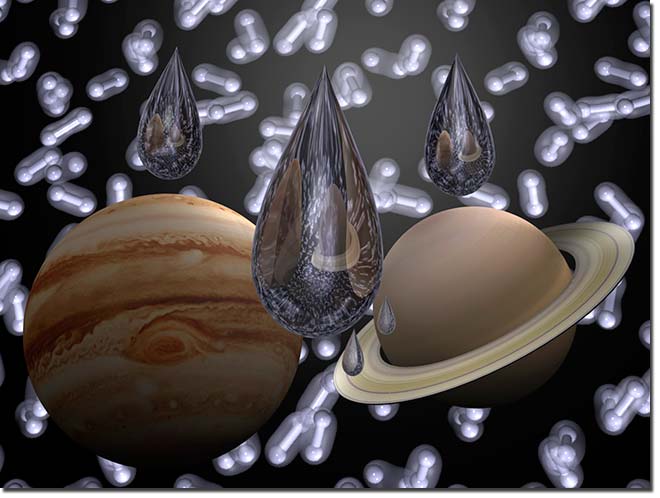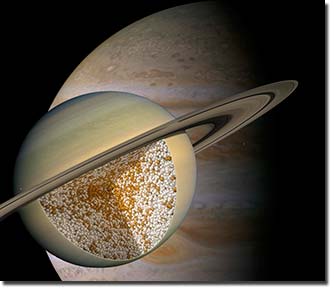Soon models that recreate the formation of Jupiter and Saturn will look completely different

Today there are several models that explain the development processes of the gas giants - Jupiter and Saturn. Both planets are composed mostly of hydrogen and helium, and they emit more energy than they receive from the Sun.
Over the years many models have tried to explain the evolution and composition of the gas giants, and they have been developed to explain the relationship between age, size, mass and luminosity. Various discoveries have refined the models and given clear explanations for the various processes related to the planets, but the latest model still contains several internal contradictions.
While today it is possible to explain the energy radiation of Jupiter that has remained since its formation 4.55 billion years ago, the model fails to explain contradictions related to Saturn, the model does not estimate the current brightness of Saturn at all.
Groundbreaking research

For this reason, the researchers tried a slightly different approach. They determined two things, where helium and hydrogen mix and at what temperature they don't mix. By analyzing the properties of the hydrogen-helium mixture in the compressed atmospheres of Jupiter and Saturn, the researchers found what temperature is needed at a given pressure in order to dissolve helium in hydrogen.
Hydrogen and helium are the two lightest and most common elements in the universe. Because of their wide availability, they are an essential element in the study of atomic nucleus creation processes in the universe. And since they are the basic elements that make up stars and gas giants, both elements have become a central research object in this field.
Hydrogen itself provides clues to the early structure of galaxies. However, scientists have had difficulty determining under what conditions the two elements mix.
Using a simulation using the first principle of molecular dynamics, the researchers created an equation that defines the state of hydrogen-helium at extremely high temperatures (4,000-10,000 degrees Kelvin), similar to the temperature inside Saturn and Jupiter.
An American-Italian team that conducted the research used the supercomputers at the Lawrence Livermore National Laboratory at the University of Illinois to conduct simulations in a wide range of densities, temperatures and compositions. The simulations helped the researchers create an equation that defines the state of the two elements given specified conditions.
The conclusion of the study
"The results of our simulation are consistent with the idea that a large part of Saturn's interior has conditions where hydrogen and helium are in separate phases," says
One of the researchers, "This could explain the apparent contradiction between today's evolutionary models and the observational data from Saturn."
Because the gas giants emit more energy - they cool down. The planets cooled since their formation and the temperature dropped to a temperature where the two elements stopped mixing. This process, which probably happened in the past on Saturn, can lead to the creation of "helium droplets" that fell towards the interior of the planet and thus created an additional source of heat.
Summary
It turns out that the temperature at which the two elements mix is several times higher than the temperature prevailing on the gas giants. This conclusion in itself justifies making changes to the current models related to Saturn and Jupiter.
For the announcement of the Lawrence Livermore National Laboratory

5 תגובות
A. Ben-Ner
the critical point of helium is found, according to http://en.wikipedia.org/wiki/Helium At 5.19 degrees Kelvin and 0.227 millipascals.
to Remy
It is clear that this process also occurred in the past, however, if the emission of heat, from the gas giants, is greater than the heat they absorb from the sun, then this means that the process of the gravitational collapse of the helium, towards the center of the planet, is still ongoing. This process is the source of the emitted energy. Another question that arises is, what are the accumulation modes of the helium in the inner layers
of the gas giants, at least according to the computational models. Do not rule out the possibility that in the innermost layers the helium is in a hot liquid state, due to the high pressure.
The described process happened in the past. And this explains the inconsistencies in the existing models.
A. Ben-Ner:
I also understood it in a similar way and in more detail - I would describe it like this:
The sun does not provide Saturn with enough radiation to keep the gases in a state where their diffusion outweighs the sinking of their liver - the helium - towards the center. As a result the helium does sink. This happens as a "rain" of helium falling toward the center from areas where the gases are mixed together.
The fall of this rain is a loss of potential energy of gravity and this energy is first transformed into kinetic energy of the movement of molecules and later into radiation energy.
This is how the gap between the absorbed energy and the emitted energy is explained (which is higher because in addition to the absorbed energy, the heat energy created by the same rain is also emitted)
A question for Rami:
If I understood correctly, then the conclusion from the article is that the core of the gas giants is composed of helium because,
On the one hand it is heavier than hydrogen and on the other hand the temperature there is not hot enough to cause the helium and hydrogen to mix. is that so ?